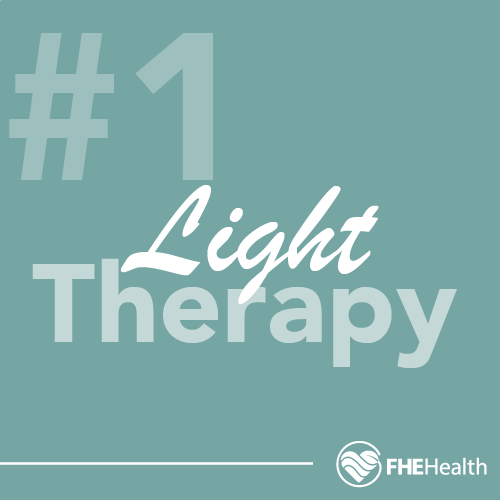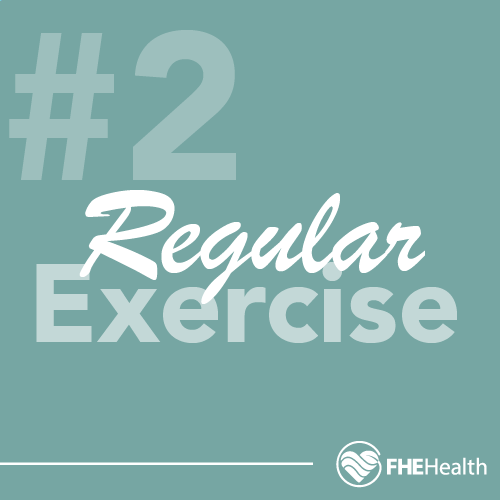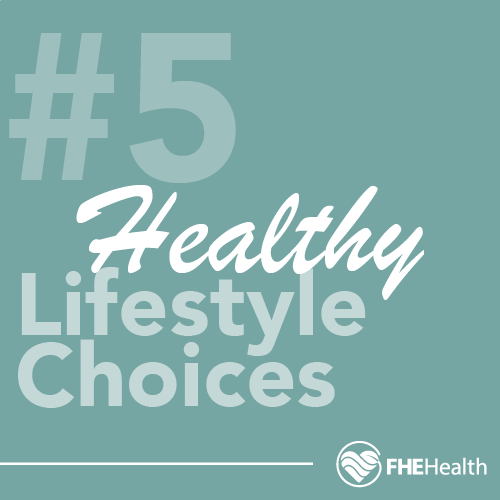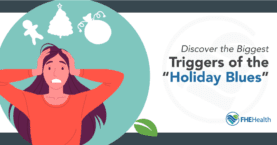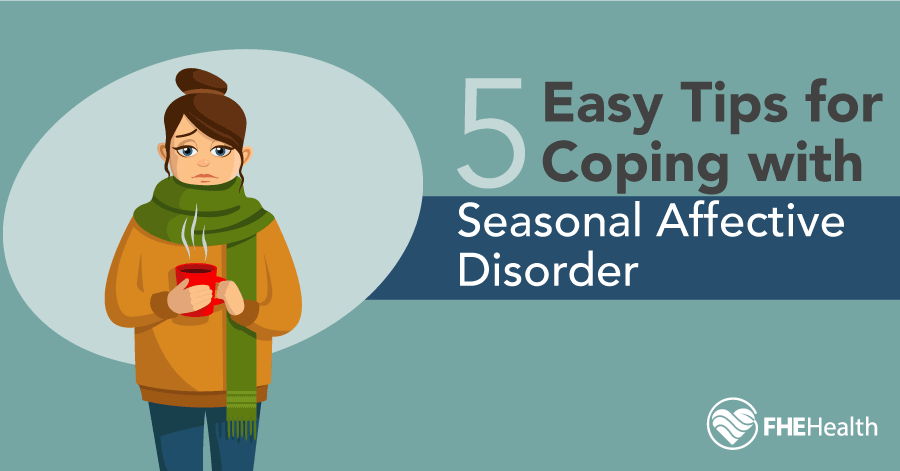
Updated September 27, 2025
When the temperatures drop, it can be hard to get outside and get exercise and fresh air. Because you are stuck inside for most of the day, you may begin to experience seasonal affective disorder (SAD). A type of depression, SAD typically comes and goes with the seasons, but it can leave you feeling sad and blue and extremely fatigued.
The good news is that there are several things you can do to get help for seasonal affective disorder, including treatment options that can leave you much happier until warmer weather comes.
What Is Seasonal Affective Disorder?
Seasonal affective disorder is a seasonal pattern that comes and goes about the same time each year. Symptoms may start off mild and get progressively worse as you move further into the season. For most, symptoms of SAD start late in the fall and continue until spring. Once warmer weather begins, it’s easy to snap out of it. For others, spring onset or summer depression starts in the spring and continues until temperatures start cooling off. Spring onset is less common than fall onset, but people with heat sensitivities and those who become frustrated with the heat may prefer cooler temperatures, making summertime unbearable and making coping with seasonal depression difficult.
The exact cause of SAD is not known. However, some scientists agree it occurs due to a chemical change in the brain that happens with less sunlight exposure. The body naturally produces more melatonin at night and when the days are shorter. Melatonin is responsible for causing feelings of fatigue, so with more darkness, you are likely to feel more fatigued and lethargic throughout the day. SAD also affects older individuals or those over the age of 20, and it occurs more frequently in women than in men. Approximately 5% of all Americans live with SAD.
Aside from lethargy and fatigue, SAD can produce a range of other symptoms/side effects, including:
- Loss of interest in hobbies and pastimes
- Increased sensitivity to criticism or rejection
- Social withdrawal
- Increase anxiety or irritability
- Feelings of hopelessness, guilt, and sadness
- Decreased libido
- Difficulty concentrating
- Change in appetite
- Tendency to oversleep
- Heavy feeling in the arms or legs
Differentiating SAD and Depression
Seasonal affective disorder is very similar to regular depression. Individuals with SAD may actually have more symptoms of depression than those who have been diagnosed with regular depression; however, these symptoms only occur seasonally. SAD is a milder form of a major depressive disorder. One notable difference is that, with SAD, there will be times of the year where you can laugh and receive comfort and live a somewhat normal life. With depression, it can be tough to get enjoyment from anything or take part in your usual social activities. Depression also often brings symptoms of body aches, feelings of worthlessness, and suicidal thoughts.
An Overview of the Statistics on Seasonal Affective Disorder
The important thing to remember if you are suffering from SAD is that you are not alone. While every person is different, understanding the general trends in those with SAD can help give you a base knowledge and better starting point when planning your own treatment plan. Consider the following stats on seasonal affective disorder.
- Approximately 10 million Americans are affected by seasonal affective disorder.
- SAD is four times more likely to occur in women than in men.
- The average age for those affected by SAD is 18 to 30.
- Only 6% of those affected by SAD require hospitalization.
- Many individuals who suffer from SAD have at least one relative with a psychiatric disorder.
5 Preferred Methods of Treatment for Seasonal Affective Disorder
While many people refer to SAD as the “winter blues,” there’s more to it than that. It can often leave you overwhelmed, distressed and unable to remain focused on the task at hand. You don’t have to suffer through each episode and wait for warm weather, instead consider one of several seasonal affective disorder treatment options.Light Therapy
Lack of sunlight is contributed as one of the main causes of SAD. For this reason, once you replace the light, you should start feeling better. Also referred to as phototherapy, light therapy has proven to be extremely effective and is accomplished through the use of a lightbox, which mimics the sun’s rays. Light from the box counteracts the increased darkness outside and the lack of sunshine inside, so it basically tells your brain to wake up. Adding extra lights or stronger bulbs to a regular light won’t work; instead, you need a special light called a SAD light. A SAD light provides approximately 10,000 LUX of light and emits a small number of UV rays. To avoid light interfering with sleep patterns, a lightbox should be used first thing in the morning, and it should be used for 20 to 30 minutes at a time for best results.
Although lightboxes are safe and effective to use, it’s best to talk to your doctor before beginning this type of treatment. You don’t need a prescription for a lightbox, but they are generally recommended only for those who have been clinically diagnosed with SAD.
When using a lightbox, consider the following:
- Never look directly into the light.
- Keep the box 16 to 24 inches away from your face.
- Follow the instructions carefully.
- Be sure to relax during each treatment.
- Ask your doctor before using.
Exercise
Exercise produces feel-good chemicals like serotonin and endorphins which can help fight depression. According to the Anxiety and Depression Association of America, you are 25% less likely to suffer from feelings of depression and anxiety when you exercise or take part in some sort of regular physical activity.
While exercise in a gym can be extremely helpful, getting outside for a quick run or a walk around the block can be even more beneficial. If you aren’t into lifting weights or taking part in an exercise class, consider adding 30 to 60 minutes a day of walking into your regular routine. The important thing is to keep moving.
Medication
Antidepressants are often an effective way to help combat SAD, especially if the symptoms are severe and other methods of treatment aren’t working. Medications are also helpful if you are experiencing other forms of depression on top of SAD.
Selective reuptake inhibitors or SSRIs are prescribed for SAD and other forms of depression. These medications help boost the levels of dopamine in the brain and make you feel more relaxed and happier. Individuals who opt for this form of treatment often begin by taking a low-dose, long-acting pill early in the fall to ensure the pills begin working before the onset of SAD.
Cognitive Behavioral Therapy
Some evidence supports the use of cognitive-behavioral therapy (CBT) for coping with seasonal depression. A type of psychotherapy, CBT helps people identify negative thoughts and replace them with more positive ones. With CBT, individuals are taught that depression from SAD is not a choice but an innate part of their behavior. As a result, the individual is taught to refocus negative energy by reading a book, spending time with friends, or taking up a new hobby. CBT can be used as a stand-alone treatment method or used in conjunction with other SAD treatment methods.
Healthy Lifestyle Choices
Depression can often make you reach for unhealthy methods of coping, like overeating, choosing junk food over healthy foods, staying up too late, and drinking. While these choices may make you feel good temporarily, they aren’t a long-term way of managing symptoms of SAD.
When coping with seasonal affective disorder, start by eating a healthy diet. Cut out sugar and caffeine, and abstain from drinking as much as possible. Schedule a regular checkup with your doctor to monitor your blood pressure and heart rate, and consider purchasing a portable machine to monitor your rate on your own. Consider taking up relaxation techniques such as yoga or meditation, and be sure you get a good night’s sleep every night.
What Can You Do to Mitigate SAD Each Year?
If you’ve been diagnosed with seasonal affective disorder, you can get a jump start on the next instance of the condition to prevent it from ever causing symptoms or at least reducing the onset of symptoms.
Start by placing a bright light at your desk at work or in a work area at home. Start using the lamp before symptoms of SAD begin to ensure you are getting enough light throughout the day. For the bedroom, consider using a daylight alarm. This clock has an integrated light that starts off dim and gets brighter gradually to simulate sunrise. This can help rouse you out of your sleep just like a normal sunrise would.
Make regular exercise a part of your normal routine. Don’t save walks for winter or for when you are feeling blue. Consider walking several times a week, or sign up for a yoga class at your local gym. Along with exercise, try to spend more time outside getting fresh air. The benefits are doubled if you exercise outside.
Give yourself at least 30 minutes before bedtime. Turn off the television, grab a book and relax and unwind. Adjust yourself to the time change in the winter gradually by slowly turning your alarm back a few minutes every couple of days. By the time your clock changes, you will be used to getting up and an earlier time. Other tactics to combat SAD before it happens include:
- Monitor your mood and energy level
- Plan pleasurable activities during colder months
- Maintain a positive attitude
- Seek help sooner rather than later for overcoming a depressive episode
If you or someone you love needs help in coping with seasonal depression, contact FHE Health at (833) 596-3502. Our caring counselors are on call 24/7 to help you learn about your options for treatment and to help you on the road to recovery.
